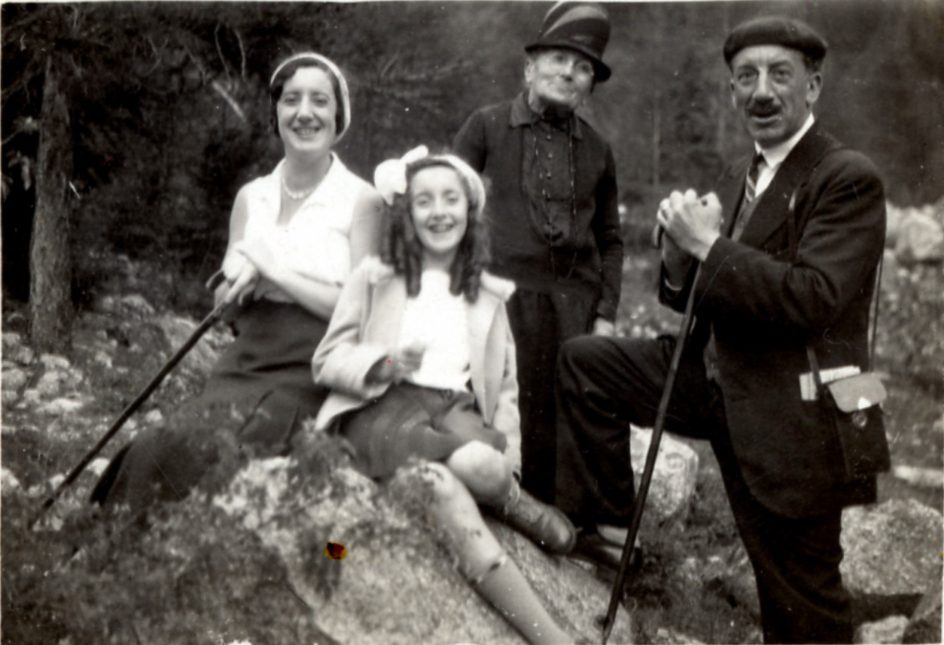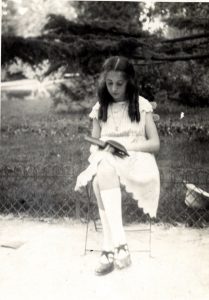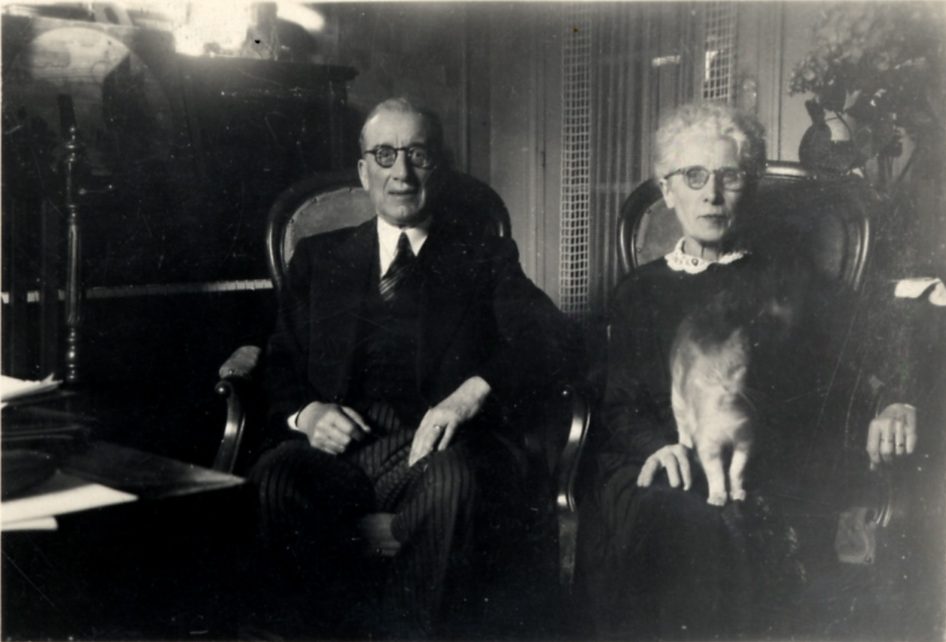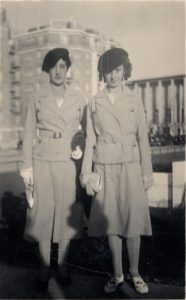1 From the Midi to Paris, 1921-1946
“I will tell you about this church’s organist, Your Eminence.
A young girl from Montpellier. When she was eleven years old,
her parents, witnessing the extraordinary development of this child’s gifts,
made the sacrifice of selling everything so they could take their child to Paris.”
—Marcel Dupré, quoted in diary entry of March 26, 1943
[T]he intimacy of this conversation was so intense that my parents undertook
to confide in the master [Dupré] the story of our life, our origins, and our rise.
This was explained by Maman with delicacy and accepted with seriousness.
—Diary entry of August 22, 1943
Behind Jeanne Demessieux’s earliest diaries and letters is the story of her origins in the south of France and how, while still a child, she came to live and study music in Paris in the 1930s and 1940s. Modern-day readers of Demessieux’s self-writings may fail to appreciate just how remarkable were her geographical and social mobility. But as implied by the above excerpts from her diary of 1940–1946, in this time and place it ran counter to probability that—however talented, intelligent, and hard-working—a girl born into a lower middleclass family, 600 kilometres from France’s cultural centre, would have opportunity to study with some of the country’s finest musicians.
Indeed, the majority of France’s noted female pianists, organists, and composers of the twentieth century were born either in Paris or within 250 kilometres of Paris, giving them much easier access to France’s elite music teachers. They include Marthe Bracquemond, Jeanne Marie Darré, Reine Gianoli, Marie-Louise Girod, Monique Haas, Yvonne Lefébure, Yvonne Loriod, Paule Maurice, Marcelle Meyer, Germaine Mounier, and Noëlie Pierront. Alternatively, if born more than 250 kilometres from Paris, these females probably had parents who were highly educated, that is, of the upper class, and in contact with their region’s social and artistic elite—if not professional musicians or artists themselves. Among examples of these are Marguerite Canal, Yvonne Desportes, Ginette Doyen, Marthe Dron, Christiane de Lisle (née Frommer), Jacqueline Robin (née Pangnier), Henriette Puig-Roget, Blanche Selva, and Magda Tagliaferro. Others had both advantages, having been born in Paris, and to upper-class parents. These include Marie-Claire Alain, Elsa Barraine, Nadia and Lili Boulanger, Céliny Chailley-Richez, Adrienne Clostre, Lucette Decaves, Rolande Falcinelli, Lélia Gousseau, Monique de La Bruchollerie, Jeanne Leleu, Renée Nizan, and Germaine Tailleferre.1
Exceptions like Demessieux are difficult to find. One was pianist Marguerite Long (1874–1966), born in Nîmes in the south of France to lower middleclass parents (her father worked for the railway).2 Her parents appear to have had no artistic background or artistic contacts; intervention came when the Parisian composer-organist Théodore Dubois, visiting Nîmes as national inspector of conservatories, urged the parents to send their twelve-year-old daughter to Paris to study. The parents were hesitant for a few years but eventually placed Marguerite in a Paris convent, run by a distant relative, to live while she studied at the Paris Conservatory.3 Marguerite Long went on to make a successful career as a concert pianist and teacher.
Another counter example appears to have been organist Marie-Madeleine Chevalier-Duruflé (1921–1999), born in Mediterranean port city of Marseille. Little is known of her early life, and nothing of her parents, but she may have been from a lower socio-economic background.4 Due to World War II, it was not until Marie-Madeleine was in her twenties that she arrived to study in Paris, but this delay did not prevent her from eventually forging an international career.5
Having in mind the backgrounds of the majority of Jeanne Demessieux’s counterparts among female musicians, the purpose of this chapter is first to describe the socioeconomic situation in which she grew up. I will then demonstrate that Demessieux’s educational opportunities depended upon her parents’ atypical thinking—specifically, ambitions for their daughter that were beyond their social class—and their willingness to make financial sacrifices.
Born in 1921, Jeanne Demessieux was a native of France’s sunny Mediterranean coast, the Midi. Her father, Étienne Prosper Demessieux, worked for the Paris-Lyon-Méditerranée (PLM) rail company, which served France’s southeast and connected the region to Paris.6 He was born on October 10, 1878 to Benoît Demessieux and Marie Martel in Sainte-Colombe, a town in central southeastern France on the Rhône River, in the general vicinity of Lyon. Part of a large family that would eventually be associated with the nearby city of Bourg-de-Péage, Étienne Demessieux was the second oldest of five boys (the youngest of whom died at age twelve and the second youngest in World War I at age twenty) and two sisters.7 Biographical details for Étienne suggest to me that his social status was lower middleclass: neither Christiane Trieu-Colleney’s account of his daughter’s life nor Étienne’s surviving employment records indicate that he passed the examination for the baccalaureate, the climax of a secondary school education and a must-have for upper middleclass status.8
Documentary evidence of Étienne Demessieux’s life comes largely from archived records relevant to his railroad company pension. These show that he began his compulsory military service around age twenty, in 1898, completing it on September 20, 1902.9 His pension records tell us that he was taken on by the PLM railroad company in March 1905. Exactly one year later, his employment was made permanent, at which time he joined the company pension plan. Some three months after that, on July 11, 1906, Étienne married Madeleine Mézy in Aigues-Mortes.
The couple’s first daughter, Yolande, was born on June 26, 1908; her place of birth is not documented in readily available sources, though the family may already have been living in Montpellier, a major rail stop and transfer point near the Mediterranean Sea. There is no record of where the Demessieux family lived prior to Montpellier or when they established themselves there. What we do know is that it was in a first-floor apartment on rue Henri-René, in the vicinity of Montpellier’s Saint-Roche train station, that they lived when Jeanne Marie-Madeleine Demessieux was born on February 13, 1921, almost thirteen years after her sister.10 Étienne appears not to have served in World War I during the intervening period, perhaps because he was employed in what was, particularly in time of war, an essential service industry.
Over the course of an almost thirty-year career, Étienne Demessieux rose to the rank of senior technical controller (or inspector) in the operations department of the PLM company.11 According to Trieu-Colleney, he was a haut fonctionnaire or high-level civil servant, but this was an exaggeration: a document supporting his proposed retirement pension was signed by a highly educated administrator, named as the ingénieur en chef of the PLM company’s operations department; the chief engineer’s status would thus have equaled that of a haut fonctionnaire.12 In contrast, Étienne’s position as senior technical controller is better categorized as middle management, placing him in the classe moyenne or middle class.13 Jane Marceau specifies that this was “lower in the power and prestige scales than the English middle class.”14 For clarity I use the term lower middleclass, rather than simply middleclass, below to describe the Montpellier social milieu in which Étienne found himself and, accordingly, in which his wife and children mingled during the first three decades of the twentieth century.
There were no musicians among Étienne Demessieux’s forebears. Trieu-Colleney, wishing to explain his role as father of one of France’s greatest twentieth-century concert organists, characterized Étienne as a man of naturally refined sensibilities with an interest in the fine arts. She states that he dabbled in watercolour painting and that, as another pastime, Étienne taught himself to play a bugle.15 Most importantly, we know from Trieu-Colleney that he attended opera in Montpellier, and from Jeanne Demessieux’s diaries that he attended performances of classical music in Paris.16
His love of music would have an influence on his daughters’ education, as will be described below. Étienne also appears to have been well-read: when homeschooling Jeanne in Paris during the 1930s, he assigned to her such classics of French literature as Victor Hugo’s dramas.17 Therefore, the standard of conversation and debate around the dinner table during Jeanne Demessieux’s youth may well have been higher than their social class and father’s level of formal education would themselves indicate.

Montpellier Municipal Archives, 4S20, Fonds Jeanne Demessieux.
Jeanne Demessieux’s mother, Madeleine Marie Catherine Mézy, was born April 28, 1884, the only child of Antoine Mézy (1848–1928) and Adelaïde Guinoir (1858–1942) of Aigues-Mortes.18 Aigues-Mortes is a medieval town in the Mediterranean region of France (a little west of the Rhône River, in Provence) that is mentioned in Jeanne Demessieux’s letters and diaries. To this day, traditional occupations near Aigues-Mortes have focused on the harvesting of salt from the sea and on agriculture, which has always included the cultivation of grapes. In antiquity, Provence was one of the birthplaces of French winemaking; in the nineteenth century, wine accounted for more and more wealth among the upper middleclass and for employment of the lower classes in the Midi. As suggested by reference to a member of the Mézy family in an October 20, 1935 letter from Madeleine to Yolande, grape cultivation and winemaking were likely the root of the Mézy family’s livelihood. If, in the late nineteenth century, as in the twentieth century, they were dealers in wine (which would place their status as lower middleclass), the Mézy family would have suffered financially when, in about 1880, a parasite destroyed a huge segment of Provence’s vineyards. In the wake of this blight, it took decades to restore the region’s vineyards by grafting French vine stock onto imported vines.19 Therefore, it is unlikely that Madeleine Mézy, born in the 1880s, grew up in a well-to-do family.
In her description of Jeanne’s mother, Trieu-Colleney makes no mention of academic achievement, musical inclinations, or musicians among her forebears. Her appreciation of music may, arguably, have derived entirely from her husband. But, in keeping with the renown that would eventually accrue to Jeanne Demessieux, Trieu-Colleney describes Madeleine as a distinguished woman, who displayed a strong temperament, combined, though, with a weak constitution.20
Madeleine Demessieux appears to have modelled self-confidence in developing and sustaining social relationships for her daughters. For instance, in the closing paragraphs of a 1935 letter written from Paris, she not only gives Yolande firm advice on cultivating her acquaintanceship Monsieur Le Boucher (director of the Montpellier Conservatory), orders her to send flowers and pass on news to Madame Mellot-Joubert (whose hyphenated name makes her sound upper class), but also asks that her regards be conveyed to two other social contacts in the Midi.21 Moreover, Madeleine had an eye and ear for the higher echelons of life: in a conversation recorded by Jeanne in her diary on April 16, 1946, she refers to herself as wanting to make her younger daughter une femme du monde, meaning “a woman of the world” or “society woman.”
Intriguingly, Madelaine Demessieux’s method of raising her daughters was the opposite of her husband’s. Étienne’s personality, according to Trieu-Colleney, was cheerful and gentle, and his manner with his daughters always calm and affectionate.22 Rather than inclined to be tender, Madeleine was demanding to the point of obsessiveness, meanwhile concealing her demands behind tremendous emotionalism.23 Consistent with these characterizations, Jeanne Demessieux’s diaries and letters from the 1940s depict her father as supporting her by being a calming influence while her mother urged her on and emboldened her, though not in a way that Jeanne felt excessive.24
In my descriptions of the personalities and parenting decisions of Jeanne’s father and mother, two features are foremost. Whereas the standard parental images in France of the time were the father as “dogmatic and strict paterfamilias” and the mother as conciliatory inculcator of moral and family principles, Jeanne’s parents reversed these roles, providing for her a model of an assertive female.25 Each also acted or looked beyond their social class, Étienne in his interests, Madeleine in her aspirations, and both in planning Jeanne’s education.
As far as scholastic endeavors were concerned, Étienne Demessieux’s interest in music was such that he encouraged both of his daughters to make music the prime focus of their educations. Accordingly, it appears that neither daughter attended primary school for very long. In the case of Yolande Demessieux, a serious illness, originating during infancy, interrupted her schooling. When she recovered, her parents decided that instead of returning to school to catch up on her general education she should devote her days to studying music and piano-playing.26 This decision was probably taken for practical reasons. First, her father would have been able to guide her primary-level education by homeschooling her. Secondly, if Yolande, so as to catch up in her academic studies, had stayed in school past the mandatory age of thirteen, she would not have been able to accept paid employment to help assist the family financially, as was usual in lower-class families. However, as an accomplished musician with credentials from Montpellier’s music conservatory, Yolande was able by early adolescence not only to earn money teaching young students privately, but also to hold an organist’s post from the age of 13.27 In fact, she became her younger sister’s first music teacher, solely responsible for her musical development from ages three to seven.28
In Jeanne’s case, her parents’ decision against continuing to send her to primary school was initially made because she had complained that her classroom teacher repeated herself too often.29 To homeschool Jeanne, Étienne and Madeleine selected an unusual teacher. He was a member of the Demessieux family who had moved to Montpellier and was simply known as “le capitaine Demessieux”; Trieu-Colleney identifies him as a cousin of Jeanne’s father.30 The gentleman’s title—which in the French military denotes a junior officer in command of one- to two-hundred men—suggests to me that he was a graduate of one of France’s military schools, such as the École spéciale militaire de Saint-Cyr. Like others of France’s prestigious institutions of higher learning (the grandes écoles), these specialist military schools accepted only the cream of baccalaureate winners who had passed further competitive examinations. Captain Demessieux’s credentials therefore placed him, and his accustomed social milieu, in the upper middleclass.
Captain Demessieux’s superior education was probably the reason Jeanne’s parents enlisted him to tutor her in their home; this lasted while she was between the ages of about eight and eleven years.31 I would argue that in her lessons Captain Demessieux would have honed and supplemented the social manners and style of conversation, the savoir faire, that her parents and older sister could teach her. This would account for how easily Jeanne would converse in Parisian upper-class company as a young adult in the early 1940s.32

Montpellier Municipal Archives, 4S20, Fonds Jeanne Demessieux.
It was possibly from his instruction that Demessieux learned the rhetorical device that constructs a line of reasoning in the format thesis-antithesis-synthesis (or introduction-body-conclusion); French children were taught this early on in school to prepare them for competitive written and oral examinations.33 At the same time, it seems likely that Captain Demessieux ignored the elements of primary-school curricula specific to girls’ classes which involved instruction in moral precepts, running of the home, and care of a family.34 This would arguably have maximized the amount of time Jeanne could spend practising and studying music. Already in 1928, at age seven, she had qualified to enter solfège and piano classes at the Montpellier Conservatory, eventually studying in the piano class of Léonce Granier.35 Trieu-Colleney emphasizes that what came to be lacking in her childhood was opportunity to play and socialize with young people her own age.36
By the time Demessieux was around eight years old her parents noted that she was unusually precocious in both music and general studies.37 Their reaction was to think outside the limitations of their own educations and make an early decision as to their younger child’s educational path: “Which to choose? Music? Or [general] studies?”38 Hypothetically, an academically inclined daughter deserved to follow her primary-school education with attendance at one of the best girls’ secondary schools to which her parents could afford to send her. After graduating she would ideally enter and succeed in the national competition for a baccalaureate, and then study to qualify for entrance to one of France’s grandes écoles. Once accepted, she could aspire to a diploma, called a “prize,” that would open the door to a career in the civil service or as an advanced-level teacher. But if a female were to choose music as her career, her path changed after primary school because France’s national school for professional musicians did not require the baccalaureate for entrance. To be accepted to the Paris Conservatory, France’s grande école for music, applicants, regardless of gender, would be required to play their musical instrument at the level of the very best of young adults.
Jeanne Demessieux chose music as her career—“I want to give piano concerts,” she announced at age eight—and her parents thereafter did all that was needed to facilitate her blossoming as a musician.39
This raises the question of what had inspired Jeanne’s ambition to be a concert pianist rather than simply to emulate her sister in becoming a teacher of piano. Perhaps, she had opportunity as a child in Montpellier to admire performers of piano recitals; it is also possible that she had read about great nineteenth- and early-twentieth-century pianists—some of whom were women.40 Demessieux’s parents, excited by Jeanne’s potential to equal these, would arguably have been aware that distinguished virtuosi among artists and musicians in France were treated as belonging to an upper class (unlike in Britain, for example, where they belong to the lower class41). To have a successful concert pianist as a daughter would have the effect of moving the entire family into the upper middleclass, a thought that would likely have appealed to Étienne and Madeleine alike.
As a student at the Montpellier Conservatory, it took Jeanne only four years to achieve what a hard-working young person would ordinarily accomplish much later, by around age eighteen: at age eleven, in 1932, she achieved first-class diplomas, called “First Prizes,” in both solfège and piano.42 The prize in piano was conferred as the result of a public concert, of which a reviewer wrote:
Three concertos, two of which were accompanied by the orchestra, concluded the concert. The one by Widor, in particular, full of [musical] qualities, contained a good number of pianistic difficulties. Its orchestration was powerful, too powerful. Mlle Demessieux’s performance emphasized an attractive, budding virtuosity and recalled somewhat the fine manner of Mme Ibanez-Fauquier. Nevertheless, the dryness [austérité] of this serious and powerful work, somewhat strong for her, gave impressions (I don’t know how to say this) from the contrived to a preciousness that certainly tells of a fine temperament.43
Despite Demessieux’s First Prize in piano from the Montpellier Conservatory, and as was the case for holders of a baccalaureate aspiring to compete for entrance to one of France’s other grandes écoles, Jeanne would need further study to prepare her to audition for entrance to the Paris Conservatory. This would have to be with the very highest level of teacher, such as could only be found in Paris. Therefore, in 1932 Étienne Demessieux requested and obtained from his employer a transfer from Montpellier to Paris, solely in the interest of Jeanne’s training beyond her present diploma in piano.44 To make the move took not only ambition on his part, but also faith that, after intense preparatory work with Paris teachers, in as short as possible a period and entirely at the family’s expense, Jeanne would prove a winner in a competition for one of the limited number of places in a piano class at France’s elite music school. Despite the gamble, Étienne sold his Montpellier household belongings in 1932, and that October installed his family in an apartment at 8 rue du Docteur-Goujon, in a primarily working-class and immigrant neighbourhood of Paris, near his new place of work, Gare de Lyon.

Montpellier Municipal Archives, 4S20, Fonds Jeanne Demessieux.
It is unclear how the Demessieux family—now consisting of husband, wife, mother-in-law, and younger daughter—made financial ends meet in Paris in the 1930s. During the three-year period May 1, 1931 to April 30, 1934, Étienne’s average annual salary was 28,000FFR before deductions, for a take-home pay of less than 2,333FFR per month.45 Rough estimates of the cost of living in Paris in 1932 indicate that this was barely enough for a family of four to make ends meet, even while living in a low-rent district. Rental of a modest, furnished apartment including light and heat would have been at least 1,250 FFR per month; food and drink would have averaged at least 1500 FFR over a month—already a total of 2,750 FFR per month.46
It has been impossible to determine how the shortfall was made up, if barely. Like Yolande, who had already contributed to the family income in Montpellier by teaching music and playing for church services, Jeanne at age twelve took up the post of organist for the Church of St-Esprit in the vicinity of the family’s apartment. Given that the parish was new and in a working-class district, this would have been for a very modest stipend.

Montpellier Municipal Archives, 4S20, Fonds Jeanne Demessieux.
One wonders, therefore, how Jeanne’s family paid for her year of private piano study in Paris and for her private study of harmony. Whatever the answer, we can assume the family suffered privation—privation that was deemed justified by the fact that once accepted to the Paris Conservatory class in a particular discipline (by virtue of being better than other contenders), her tuition would be free, as at the Montpellier Conservatory.
Raising further questions as to how the family survived financially, Étienne took early retirement with an annual pension of only 15,322 FFR in 1934, when Jeanne was only thirteen years old.47 In 1935 she wrote to her sister that she was considering taking piano students so that she could contribute more to the family income, but was dissuaded from this by Yolande, for the time being.48 It would not be until 1941 that Jeanne made mention in her diary of having a student or students of her own.49
To conclude, Jeanne Demessieux’s birthplace in the extreme south of France, her family’s limited financial means, and their lower middleclass status, made it remarkable that she came to study music in Paris in 1932, when only eleven. Extraordinary circumstances made this possible. Her parents were exceptional in their ambitions for their daughter that looked beyond their own social milieu. Fortuitously, her father’s employment was transferable to Paris. Furthermore, the Demessieux parents were willing to make financial sacrifices to support her while she studied there. As would eventually prove important, prior to the move Jeanne had been home-schooled by an upper-class male relative who would likely have imparted to her the manners and style of discourse of the upper classes that she would later use when socializing with her Paris mentors.
Demessieux’s earliest diary and letters were written between autumn 1932 and summer 1940 and are largely concerned with her experiences at the Paris Conservatory, or preparing to enter it. Therefore, Chapter 2 will describe the nature of the Conservatory and what it was like to study piano, composition, and organ there during Demessieux’s time.
NOTES:

